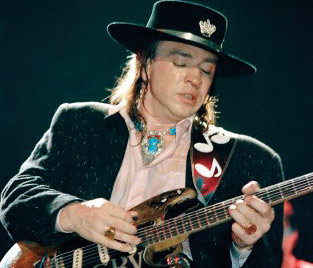Bobbyisms: Guitarist remembered

I write about random things a lot. I write a lot about random things. August 27 was a special day of note for guitarists worldwide — the twentieth anniversary of the passing of Stevie Ray Vaughan, arguably the world's best guitarist.
Born in Dallas in October of 1954, Vaughan dropped out of high school at age 16 to focus his energy on his music, finding some success on the Texas scene in the 1970s. After impressing a number of industry players at high profile festivals and private gigs, Vaughan and Double Trouble got their break when legendary producer Jackson Browne gave them three days of free recording time in his personal studio.
The band turned those three days into 10 tracks and their debut album, Texas Flood. Around the same time, Vaughan gained real notoriety by being hired to play lead guitar tracks for David Bowie's 1983 record, Let's Dance, but turning down the opportunity to play with Bowie on tour in order to focus on his band.
Through the 1980s, Vaughan's consumption of drugs and alcohol spiraled out of control, and after a breakdown one day in 1986, he conceded to attend rehab in Atlanta. On the wagon ever after, Vaughan's career was at an all-time high the night he died.
This August 27, countless people published personal blog posts, marking their memories of Vaughan — not only just as a formidable guitar player, but as a real person, capable of pain and recovery and change.
The curious coincidence between those posts? A significant number of these online memorials included video footage of Vaughan's concert set at the El Mocambo in downtown Toronto. Music authorities and performers posted alike — from Jeff Woods of The Legends Of Classic Rock radio show to recording artist John Mayer and everyone in between — refer to this gig, one of Vaughan's best, as a true measure of the man.
Vaughan played the legendary live music club early in July of 1983, not one month after his debut album was released. The show was filmed at the time, and although it was eventually released on video after Vaughan's death, the audio was never officially released by any source.
The first copy of the concert that I ever came across was called GRay and was made in Italy. Where the recording originally came from may yet be a mystery, hailing back to the world of bootleg recordings as it existed then, long before the Internet era began.
“There are two kinds of bootlegging,” music geek extraordinaire Alan Cross (of The Ongoing History Of New Music radio show) wrote to me by email. “The first involves people grabbing soundboard recordings or demos, shipping them off to a copyright-loose country and pressing everything onto CDs. They're then sold under the counter to special customers.”
“The second is a high-tech version of the tape-trading culture first perpetrated by the Grateful Dead,” he continued. “The rule is, ‘If you take something, you must give something back. And you must never, EVER sell any of these recordings.'”
Cross points out that the concept will be familiar to those who download media with torrents — once you download, you're expected to give back in the way of offering the files back in the form of seeds.
Sadly, little else still exists from the culture of bootlegging, one steeped in self-addressed, stamped envelopes, blank tapes and the kind of travail that could only be appreciated by the most passionate of music fans.
And without knowing exactly how Vaughan's performance at the El Mocambo came to be a bootleg recording, one thing is clear: this performance, filmed at the very beginning of his incredible career, has had a strong impact on countless guitarists and musicians in the decades since.
“I wanted to play saxophone, but all I could get were a few squeaks,” Vaughan told Guitar World back in September, 1983. “So, my big brother was playing guitar and I figured I'd try it too.”
Little wonder the man is as remembered to this day for his charming nonchalance as his blistering guitar techniques. I'm out of words.













